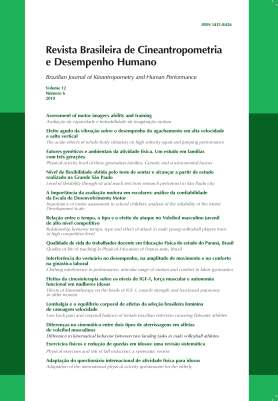Level of flexibility through sit and reach test from research performed in São Paulo city
DOI:
https://doi.org/10.1590/1980-0037.2010v12n6p415Resumen
The objective of this study was to examine the level of flexibility in men and women of different ages by the sit-and-reach test and to classify them according to the Canadian Standardized Test of Fitness (CSTF). The results were used to elaborate a new table that reflects the population studied. The sample consisted of 16,405 physically active and inactive subjects who were divided according to age: 15 to 19 (n = 954), 20 to 29 (n = 2916), 30 to 39 (n = 2161), 40 to 49 (n = 2333), 50 to 59 (n = 2739), 60 to 69 (n = 3195), and > 70 years (n = 2107). Percentiles were calculated using the original test scores and the 20th, 40th, 60th and 80th percentiles were used as cut-offs for classification as poor, below the average, average, above the average and excellent, respectively. According to the CSTF classification, the age groups from 15 to 39 years were classified as poor, with mean flexibility ranging from 24.805±9.684 to 26.130± 10.111 cm in women and from 21.480±9.905 to 22.848±9.648 cm in men. In the 40- to 69-year age groups, mean flexibility ranged from 22.768±9.627 to 25.396±9.547 in women and from 16.396±10.136 to 19.935±9.192 cm in men and was classified as below the average. Although most of the subjects performed regular exercise, the mean flexibility level observed did not correspond to the average suggested by the CSTF, demonstrating the importance of elaborating national reference tables and of establishing new normative values such as the table proposed in this study.
Publicado
Número
Sección
Licencia

Direitos Autorais para artigos publicados nesta revista são do autor, com direitos de primeira publicação para a revista. Em virtude da aparecerem nesta revista de acesso público, os artigos são de uso gratuito, com atribuições próprias, em aplicações educacionais e não-comerciais, desde que seja dada a atribuição. Esta obra foi licenciada com uma Licença Creative Commons Atribuição 4.0 Internacional - CC BY


